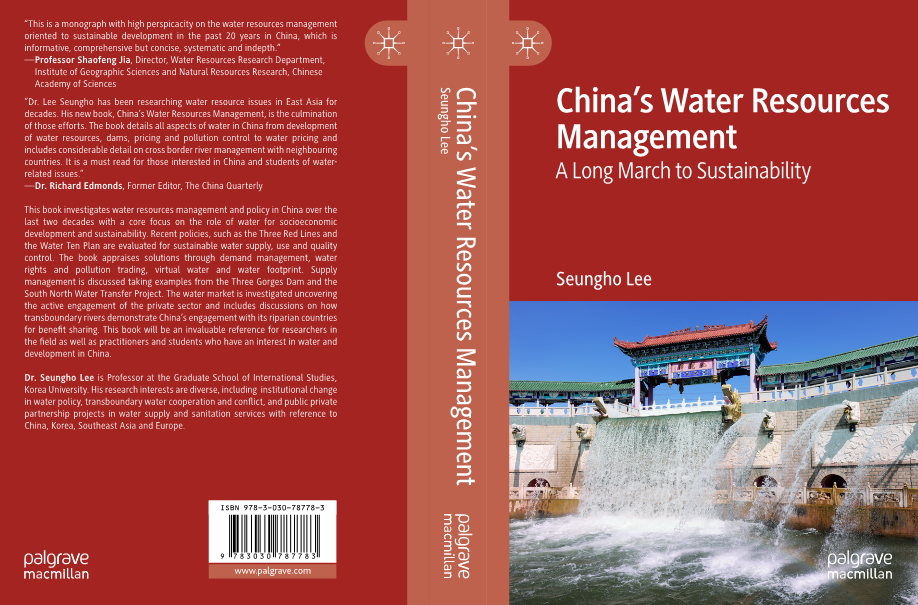China's water resources management: a long march to sustainability
This book aims to evaluate one of the most challenging issues for China’s development, water resources management, with a special focus on the period after the new millennium. The rapid modernization in the reform era has brought about the revolutionary transformation of political, socioeconomic, and environmental governance systems, and the water sector is not an exception. China suffers from water shortage, water pollution, and water-related disasters including flood and drought, and degradation of water and ecosystems. These issues are intertwined with structural problems that have stood out during the reform era, such as urbanization, population growth, industrialization, and climate change.
Confronted with these challenges, the Chinese government has endeavored to establish effective water resources management systems over the last few decades for achieving sustainable development. An array of policy shifts favoring sustainable development have been introduced in water resources management, e.g., the Three Red Lines in 2011, the Water Ten Plan in 2015, and the Ecological Red Lines in 2016. These macro- and national level policies encapsulate a new architecture of policies, plans, and strategies in water resources management that helps envisage the future look of China’s water and environment. Ecological civilization for achieving ‘Beautiful China’ has strongly been promoted since 2016 when the 13th Five Year Plan (FYP) was officially launched, and more emphasis is placed on ecological and environmental matters than pro-growth policies and agendas in the country. China’s revolutionary march to modernization has shifted its direction from a high-speed to high-quality and green development, which is reiterated in the newly announced the 14th FYP (2021-2025) in March 2021.
The book investigates the extent to which the Chinese government has been effective in tackling a complexity of problems in water resources management, highlighting institutional frameworks, including plans, laws and regulations, and economic instruments, and physical infrastructures, such as multi-purpose and agricultural dams, aqueducts, and water and wastewater treatment facilities. Attention is paid to the overall framework of water resources management and sectoral approaches of diverse ministries, agencies and different levels of local governments together with the contribution of private sector players to water and wastewater services since the late 1990s. An interesting aspect of the book is to broaden the geographical scope of water resources management beyond China’s territorial areas, exploring transboundary river issues.
Confronted with these challenges, the Chinese government has endeavored to establish effective water resources management systems over the last few decades for achieving sustainable development. An array of policy shifts favoring sustainable development have been introduced in water resources management, e.g., the Three Red Lines in 2011, the Water Ten Plan in 2015, and the Ecological Red Lines in 2016. These macro- and national level policies encapsulate a new architecture of policies, plans, and strategies in water resources management that helps envisage the future look of China’s water and environment. Ecological civilization for achieving ‘Beautiful China’ has strongly been promoted since 2016 when the 13th Five Year Plan (FYP) was officially launched, and more emphasis is placed on ecological and environmental matters than pro-growth policies and agendas in the country. China’s revolutionary march to modernization has shifted its direction from a high-speed to high-quality and green development, which is reiterated in the newly announced the 14th FYP (2021-2025) in March 2021.
The book investigates the extent to which the Chinese government has been effective in tackling a complexity of problems in water resources management, highlighting institutional frameworks, including plans, laws and regulations, and economic instruments, and physical infrastructures, such as multi-purpose and agricultural dams, aqueducts, and water and wastewater treatment facilities. Attention is paid to the overall framework of water resources management and sectoral approaches of diverse ministries, agencies and different levels of local governments together with the contribution of private sector players to water and wastewater services since the late 1990s. An interesting aspect of the book is to broaden the geographical scope of water resources management beyond China’s territorial areas, exploring transboundary river issues.

Publisher
Palgrave Macmillan
ISBN
9783030787783
Publication date
1 Jan 2021 – 31 Dec 2021
Specialisation
Social Sciences
Theme
Environment
Region
China